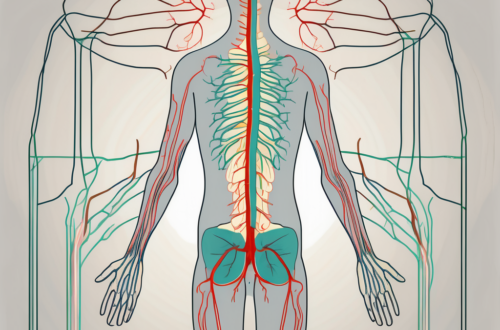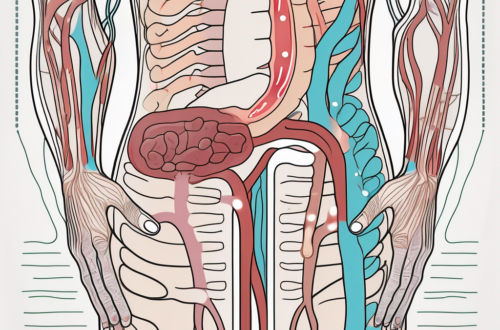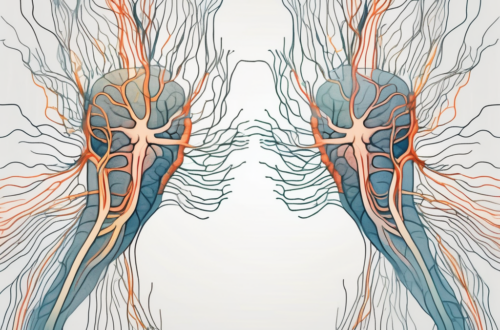The parasympathetic nervous system plays a crucial role in regulating various bodily functions, including heart function. One of the key mechanisms through which it exerts its influence is by activating muscarinic receptors in the heart. Understanding this interaction is essential for comprehending the intricate balance that maintains proper cardiac function. In this article, we will delve into the anatomy and function of the parasympathetic nerve, explore the nature of muscarinic receptors, examine the interaction between the parasympathetic nerve and muscarinic receptors, and discuss the clinical significance of this interaction in the context of heart disease treatment.
Understanding the Parasympathetic Nervous System
The parasympathetic nervous system, often referred to as the “rest and digest” system, works in opposition to the sympathetic nervous system, which governs the “fight or flight” response. The parasympathetic nervous system is responsible for conserving and restoring energy, promoting relaxation, and maintaining homeostasis. It exerts its influence through the release of acetylcholine, a neurotransmitter that binds to muscarinic receptors present throughout the body.
When we think about the parasympathetic nervous system, it’s essential to understand its anatomy and function. The parasympathetic nerve, also known as the vagus nerve, is the primary conduit through which the parasympathetic nervous system regulates various organs, including the heart. Originating in the medulla oblongata of the brainstem, it travels to different regions of the body, innervating specific structures.
In the case of the heart, the parasympathetic nerve fibers extend to the sinoatrial (SA) and atrioventricular (AV) nodes, as well as the atria. This intricate network of nerve fibers allows for precise control and modulation of heart function. When activated, these fibers release acetylcholine, which binds to muscarinic receptors on the cardiac cells, modulating their function.
The Anatomy and Function of the Parasympathetic Nerve
The parasympathetic nerve, also known as the vagus nerve, is a fascinating structure that plays a vital role in maintaining the body’s equilibrium. Originating in the medulla oblongata, a region located at the base of the brainstem, it branches out and travels to various organs and tissues throughout the body.
As the parasympathetic nerve extends its reach, it innervates specific structures, including the heart. The intricate network of nerve fibers allows for precise control and modulation of heart function. The sinoatrial (SA) and atrioventricular (AV) nodes, as well as the atria, receive these parasympathetic fibers, enabling them to influence heart rate, conduction velocity, and contractility.
When it comes to heart function, the parasympathetic nerve plays a crucial role. By regulating heart rate, conduction velocity, and contractility, it ensures that the heart functions optimally in different situations. The activation of muscarinic receptors by acetylcholine leads to a decrease in heart rate, primarily by suppressing the automaticity of the SA node. This phenomenon is known as vagal bradycardia and is particularly evident during periods of rest, relaxation, and sleep.
The Parasympathetic Nerve’s Role in Heart Function
The parasympathetic nerve’s influence on heart function goes beyond heart rate regulation. It also plays a significant role in coordinating the electrical signals that allow the heart to beat effectively. The conduction of electrical signals through the atrioventricular (AV) node is crucial for proper coordination between the atria and ventricles.
Acetylcholine, released by the parasympathetic nerve fibers, binds to muscarinic receptors on the AV node, modulating its function. This modulation ensures that the electrical signals pass through the AV node at an appropriate rate, allowing for efficient contraction of the ventricles. By maintaining this coordination, the parasympathetic nervous system helps the heart pump blood effectively throughout the body.
In addition to heart rate and conduction velocity, the parasympathetic nerve also influences the contractility of the myocardium, the muscular tissue of the heart. Acetylcholine binding to muscarinic receptors exerts a negative inotropic effect, reducing the force of contraction. This modulation of contractility helps the heart adapt to different physiological demands, ensuring that it can pump blood efficiently without straining itself.
Understanding the parasympathetic nervous system and its role in heart function provides valuable insights into the intricate mechanisms that maintain our cardiovascular health. By conserving and restoring energy, promoting relaxation, and maintaining homeostasis, the parasympathetic nervous system ensures that our hearts beat steadily and efficiently, allowing us to live healthy and balanced lives.
An Overview of Muscarinic Receptors
Muscarinic receptors are a subtype of acetylcholine receptors found on various target cells throughout the body, including the heart. They belong to the broader family of G protein-coupled receptors and are named after their affinity for muscarine, a compound derived from certain mushrooms. There are five known subtypes of muscarinic receptors, each with unique signaling properties and tissue distributions.
What are Muscarinic Receptors?
Muscarinic receptors are transmembrane proteins that act as molecular switches, converting the binding of acetylcholine into intracellular signals. They are widely distributed throughout the body and play crucial roles in the regulation of multiple physiological processes, including cardiac function, smooth muscle contraction, glandular secretion, and neuronal signaling.
When acetylcholine binds to muscarinic receptors, it triggers a cascade of events within the target cell. This activation leads to the modulation of various signaling pathways, such as the activation of phospholipase C, which in turn leads to the production of inositol trisphosphate (IP3) and diacylglycerol (DAG). These second messengers then initiate a series of intracellular responses, ultimately resulting in the desired physiological effect.
One interesting aspect of muscarinic receptors is their ability to exhibit both inhibitory and excitatory effects, depending on the subtype and the specific tissue they are located in. For example, in the heart, the M2 subtype of muscarinic receptors exerts inhibitory effects on heart rate and contractility, while in other tissues, such as smooth muscle, they can have excitatory effects.
The Different Types of Muscarinic Receptors
The five subtypes of muscarinic receptors, termed M1 to M5, have distinct tissue distributions and signaling mechanisms. The M2 and M4 subtypes are predominantly expressed in the heart, making them particularly relevant to our discussion. The M2 receptors are mainly found in the myocardium, where they exert inhibitory effects on heart rate and contractility, while the M4 receptors are primarily present in the atrioventricular node and play a key role in regulating the conduction of electrical signals.
Interestingly, the M1 subtype of muscarinic receptors is widely distributed in the central nervous system and is involved in various cognitive functions, such as learning and memory. Dysfunction of M1 receptors has been implicated in certain neurological disorders, including Alzheimer’s disease.
The M3 subtype of muscarinic receptors is found in various exocrine glands, such as salivary glands, sweat glands, and lacrimal glands. Activation of M3 receptors leads to increased secretion of saliva, sweat, and tears, contributing to the regulation of bodily fluids and temperature.
Lastly, the M5 subtype of muscarinic receptors is less well-studied compared to the other subtypes. It is found in various tissues, including the brain, and its specific functions are still being elucidated.
In conclusion, muscarinic receptors are a diverse group of receptors that play critical roles in the regulation of various physiological processes. Understanding their distribution and signaling mechanisms is crucial for developing targeted therapies for conditions involving muscarinic receptor dysfunction.
The Interaction between the Parasympathetic Nerve and Muscarinic Receptors
The activation of muscarinic receptors in the heart by acetylcholine released from the parasympathetic nerve leads to specific cellular responses, mediating changes in heart rate, conduction velocity, and contractility. Understanding this interaction requires an appreciation of the mechanism of receptor activation and the subsequent impact on cardiac function.
The Mechanism of Activation
Upon binding of acetylcholine, muscarinic receptors undergo conformational changes that activate G proteins located in the cell membrane. These G proteins, in turn, trigger intracellular signaling cascades that alter the activity of ion channels and other effector systems in the cell.
In the case of the heart, activation of M2 receptors leads to the activation of G protein-gated potassium channels (Kir3.1/3.4), resulting in hyperpolarization and the suppression of pacemaker activity in the sinoatrial (SA) node. This ultimately slows down heart rate.
However, the interaction between the parasympathetic nerve and muscarinic receptors is not limited to the SA node. Muscarinic receptors are also present in other regions of the heart, such as the atria and ventricles. Activation of these receptors can have different effects on the electrical and mechanical properties of these cardiac regions.
For example, in the atria, the activation of muscarinic receptors leads to a decrease in conduction velocity, prolonging the time it takes for the electrical signal to propagate through the atrial tissue. This delay allows for efficient filling of the ventricles, optimizing cardiac output.
In the ventricles, the activation of muscarinic receptors has a negative inotropic effect, meaning it reduces the force of contraction. This inhibition of contractility helps to preserve myocardial energy and reduce oxygen demand, especially during periods of rest or low physical activity.
The Impact on Heart Function
The activation of muscarinic receptors by the parasympathetic nerve exerts profound effects on heart function. By decreasing heart rate, the parasympathetic nervous system allows for efficient filling of the ventricles and efficient cardiac output.
Additionally, the inhibition of contractility through the negative inotropic effect helps to preserve myocardial energy and reduce oxygen demand. This is particularly important in maintaining a balance between oxygen supply and demand, especially during stressful situations or in individuals with compromised cardiovascular function.
Furthermore, the parasympathetic nerve plays a critical role in the regulation of heart rate variability. Heart rate variability refers to the variation in the time interval between consecutive heartbeats. It is an indicator of the heart’s adaptability, resilience, and overall cardiovascular health.
A healthy heart exhibits a certain level of variability in heart rate, which reflects its ability to respond to different physiological and environmental challenges. The parasympathetic nervous system, through its interaction with muscarinic receptors, contributes to the modulation of heart rate variability, ensuring the heart’s adaptability and maintaining cardiovascular homeostasis.
In conclusion, the interaction between the parasympathetic nerve and muscarinic receptors in the heart is a complex and finely regulated process. Understanding the mechanism of receptor activation and the subsequent impact on cardiac function provides valuable insights into the intricate control of heart rate, conduction velocity, and contractility. This knowledge is essential for developing therapeutic interventions targeting the parasympathetic nervous system to manage cardiovascular diseases and optimize heart function.
The Clinical Significance of Parasympathetic Nerve and Muscarinic Receptor Interaction
The interaction between the parasympathetic nerve and muscarinic receptors in the heart carries significant clinical implications. Understanding this relationship can inform the development of therapeutic interventions for various heart conditions and provide insights into potential avenues for future research.
The parasympathetic nervous system plays a crucial role in regulating heart rate and cardiac function. It exerts its influence through the release of acetylcholine, which binds to muscarinic receptors on the surface of cardiac cells. Activation of these receptors leads to a cascade of intracellular events that ultimately result in a decrease in heart rate and the contraction force of the heart.
Impaired parasympathetic nerve and muscarinic receptor interaction can have detrimental effects on cardiac health. For instance, in heart failure, there is a reduction in parasympathetic activity, leading to an imbalance between sympathetic and parasympathetic stimulation. This imbalance can contribute to the progression of heart failure and worsen symptoms such as shortness of breath and fatigue.
Implications for Heart Disease Treatment
The dysregulation of the parasympathetic nervous system and muscarinic receptor signaling can contribute to the pathophysiology of various cardiac disorders, such as heart failure, arrhythmias, and cardiac ischemia. Pharmacological agents that modulate muscarinic receptor activity, such as beta blockers or drugs targeting cholinergic pathways, may be employed to rebalance autonomic regulation and improve cardiac function.
For example, beta blockers are commonly prescribed to patients with heart failure. These medications block the effects of sympathetic stimulation on the heart, allowing the parasympathetic nervous system to exert its influence more effectively. By reducing heart rate and the workload on the heart, beta blockers can improve symptoms and slow the progression of heart failure.
It is important to note that such interventions should only be pursued under the guidance of a medical professional, as individual patient characteristics and underlying conditions must be taken into account to ensure optimal outcomes. The dosage and choice of medication should be tailored to each patient’s specific needs and closely monitored to minimize potential side effects.
Potential for Future Research and Therapies
The intricate interplay between the parasympathetic nerve and muscarinic receptors in the heart presents a promising avenue for future research and therapeutic exploration. A deeper understanding of this interaction may lead to the development of targeted interventions that can selectively modulate specific aspects of cardiac function, potentially mitigating the impact of cardiac diseases and improving patient outcomes.
Researchers are actively investigating novel approaches to manipulate the parasympathetic nervous system and muscarinic receptor signaling. For instance, gene therapy techniques are being explored to enhance parasympathetic activity or modify muscarinic receptor expression in the heart. These approaches hold the potential to restore autonomic balance and improve cardiac function in patients with heart disease.
Additionally, further exploration of this topic may unveil novel approaches to manipulating autonomic balance and fine-tuning cardiovascular regulation. For example, targeted drug delivery systems that specifically target muscarinic receptors in the heart could minimize off-target effects and enhance therapeutic efficacy.
In conclusion, the interaction between the parasympathetic nerve and muscarinic receptors in the heart has significant clinical implications. Understanding this relationship can inform the development of therapeutic interventions for various heart conditions and provide insights into potential avenues for future research. Continued research in this field holds promise for improving the treatment of cardiac diseases and enhancing patient outcomes.
Conclusion
In conclusion, the parasympathetic nerve’s activation of muscarinic receptors in the heart plays a vital role in maintaining proper cardiac function. This dynamic interaction significantly influences heart rate, conduction velocity, and contractility, ultimately shaping overall cardiovascular health. Understanding the delicate balance between the parasympathetic nervous system and muscarinic receptors provides insights into the pathophysiology of heart disease and offers potential avenues for therapeutic interventions. As always, it is crucial to consult with a medical professional for personalized advice and appropriate treatment options.





